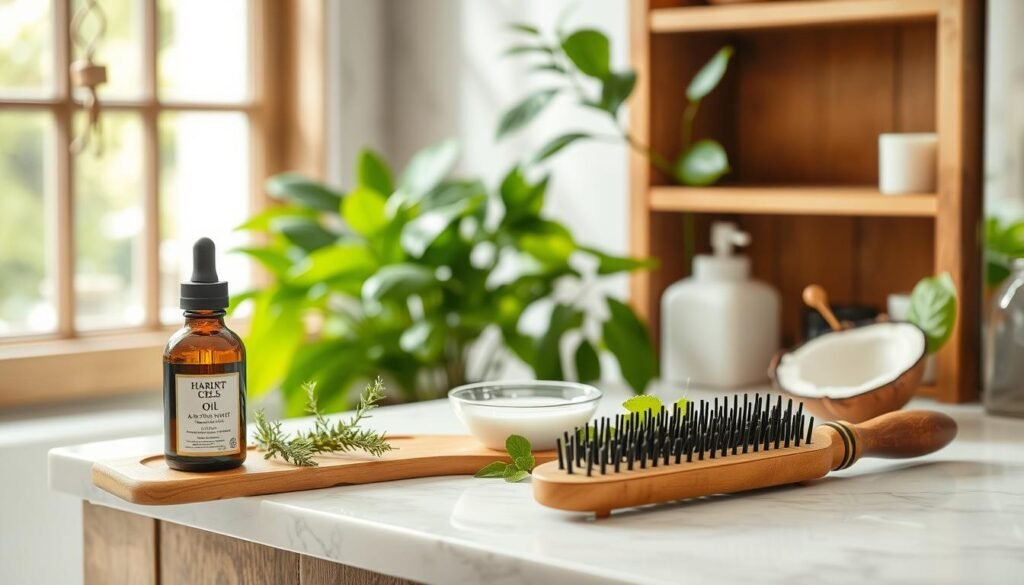Did you know more than half of people worldwide have dandruff at some point? It’s not just about flakes. It also brings discomfort. Many turn to anti-dandruff hair oils for help. These oils are loved for making the scalp healthy and stopping flakes. But, it’s important to know the right way to use them for the best results.
This guide will show you the must-know Anti-Dandruff Hair Oils – Dos & Don’ts. You’ll learn how to really change your hair care routine. We’ll bust myths and share how to apply these oils right. Our goal is to help you keep your scalp healthy, nourish your hair, and get rid of dandruff.
Key Takeaways
- Understanding the root causes of dandruff is vital for effective treatment.
- Regular use of the right anti-dandruff hair oils can help maintain a healthy scalp.
- Choosing products with antimicrobial ingredients can combat dandruff effectively.
- Over-oiling can lead to unwanted dryness and scalp irritation; moderation is key.
- Consulting a dermatologist is recommended for persistent or severe dandruff issues.
Understanding Dandruff and Its Causes
Dandruff affects about half of adults worldwide. It appears when dead skin cells shed, creating tiny, white flakes. These flakes may lead to an itchy and irritated scalp. Knowing the dandruff causes is key to handling and treating it effectively.
What Exactly is Dandruff?
Dandruff signals seborrheic dermatitis, with its severity ranging from mild flaking to serious irritation. Both men and women can get it, but men are more prone. Symptoms include oily flakes and dryness, sometimes even on eyebrows. People with Parkinson’s or HIV are more at risk.
Common Triggers of Dandruff
Many things can trigger dandruff.
- Lack of moisture and dry weather cause scalp dryness and flaking.
- Some hair care products can build up and irritate the scalp.
- Too much sun makes the condition worse.
- A fungus named Malassezia globosa flourishes in oily areas, leading to dandruff.
- A diet imbalance and too much yeast can also increase dandruff.
How Lifestyle Factors Contribute to Flakes
Stress and how we live affect scalp health and dandruff levels. Stress, lack of sleep, and not washing enough can make it worse. Good scalp hygiene, balanced shampooing, and relaxation can reduce dandruff. Scalp massages and sun protection help, too. If dandruff keeps bothering you, see a dermatologist.
The Role of Hair Oils in Scalp Health
Hair oils are key for keeping the scalp healthy, especially for those with dandruff. They offer more than just good looks. These oils hydrate and soothe the scalp, fighting dryness and boosting health.
How Oils Can Benefit a Dandruff-Prone Scalp
Using certain oils can help those with dandruff see improvements. Oils like olive oil and grape seed oil are packed with benefits. Olive oil has Vitamin E and fats that protect hair and trap in moisture. This is great for reducing dry scalp, a common cause of dandruff.
It’s important to not overdo it with hair oils. Using them too much can attract dirt and encourage fungus, worsening scalp problems. Oil treatments every two weeks are recommended for optimal hair health without overloading the scalp.
Understanding the Importance of Moisture
A moisturized scalp is essential to fight off dandruff. Oils are crucial for keeping the scalp hydrated and preventing irritation. Applying oils regularly boosts blood flow and brings nutrients to the hair roots, which is good for the scalp’s health.
Trying different oils can target specific issues. Bergamot oil, for instance, reduces stress and can fight skin infections. These oils’ essential fatty acids deeply moisturize the scalp, helping stave off dryness and flakiness.
Choosing the Right Anti-Dandruff Hair Oil
Finding the right anti-dandruff hair oil is key to better hair and scalp health. It’s crucial to look at the key ingredients. These impact their success. Natural oils are popular due to their antibacterial and antifungal qualities. They’re a top pick for dandruff control.
Key Ingredients to Look For
Many anti-dandruff oils contain ingredients that nurture the scalp. Here are some top elements:
- Coconut Oil: This oil moisturizes well, cutting down on dryness and flakes.
- Tea Tree Oil: It has antifungal benefits that help ease dandruff symptoms.
- Neem Oil: Known for its antimicrobial power, neem oil tackles various scalp issues.
- Sadhev Anti-Dandruff Oil: A mix of coconut, basil, and clove, this oil nourishes the scalp and combats dandruff.
Natural vs. Synthetic Oils: Which is Better?
Often, natural oils beat synthetic ones, especially for those with sensitive skin. Synthetic oils may have harsh chemicals like sulfates and parabens. These irritants can make dandruff worse. But natural oils tend to be gentler and less likely to irritate. Choosing natural oil products might lead to a happier scalp and less irritation.
Anti-Dandruff Hair Oils – Dos & Don’ts
Using anti-dandruff hair oils can really help your hair and scalp stay healthy. Knowing the right hair oil dos and don’ts is key to getting good results. Keep these important tips in mind when using these oils in your hair care routine.
Essential Dos When Using Hair Oils
- Warm the oil before you use it. This helps the oil soak in better, nourishing your scalp more.
- Put the oil right on your scalp, especially where you get dandruff. This targets the problem areas directly.
- Massage gently with circular moves. It helps blood flow better, which is good for your hair.
- Keep the oil in for at least 3 hours or even overnight. The longer it’s in, the more it fights dandruff.
- Oil your hair regularly to reduce dandruff symptoms like itchiness and dryness.
Critical Don’ts to Avoid for Hair Health
- Don’t use too much oil; it can make your hair heavy and greasy, needing more washes.
- Avoid combing right after oiling to prevent hair breakage and damage.
- Stay away from hair dyes, style products, or heat tools post-oil. They lessen the oil’s benefits.
- Don’t go outside right after oiling; it can attract dirt, which irritates the scalp.
- Never put oil on damp hair. Dry hair absorbs oil better, avoiding product buildup.
To learn more about the right ways to use hair oils and find out more about hair oil dos and don’ts, check out products like Sadhev’s Anti-Dandruff Oil. They can make your scalp healthier.

Effective Application Techniques for Hair Oils
Knowing how to apply hair oil right is key for fighting dandruff. Proper use lets the oil deeply nourish your scalp. This guide shows the best ways to apply and how often you should do it.
How to Apply Anti-Dandruff Hair Oil Correctly
To get great results from your anti-dandruff routine, just follow these steps:
- Start with Dry Hair: Make sure your hair is dry to keep the oil strong.
- Allocate the Right Amount: Use 1-2 tablespoons of oil, based on how long and thick your hair is.
- Section the Hair: Split your hair into parts for even oil spread.
- Massage Gently: Rub the oil into your scalp with your fingertips. Do this gently for 10-15 minutes to boost blood flow and soak in better.
- Leave On: Let the oil work for 2-3 hours for the best effect.
Recommended Frequency of Application
It’s important to find the right schedule for oiling your hair. Here are some tips:
| Action | Frequency | Purpose |
|---|---|---|
| Hair Oil Application | 1-2 times per week | To nourish the scalp and fight against dandruff |
| Scalp Exfoliation | 1 time per week | To clear buildup and keep your scalp healthy |
| Washing Hair | Every 2-3 days | To maintain natural oils but still keep the scalp clean |
| Scalp Massages | At least 1 time per week | To increase blood flow and make hair roots stronger |
By sticking to these hair oil use and schedule tips, you’ll keep a strong anti-dandruff routine and ensure your scalp stays healthy.
What Not to Do After Oiling Your Hair
After using anti-dandruff hair oil, certain practices can ruin its effect. Avoid these errors to improve your scalp and hair’s health. Knowing what not to do is key for a healthy scalp and to avoid dandruff.
Common Mistakes to Avoid Post-Oiling
To get the best outcome, follow these hair care tips after oiling. Avoid these common mistakes:
- Washing hair with harsh shampoos immediately after oiling. This removes needed moisture and lessens the treatment’s benefits.
- Using hair styling products right after oil application. Gels and sprays can block oil from soaking in, causing scalp build-up.
- Combing oily hair. Combing can lead to hair breakage and damage, more so when hair is wet with oil.
- Exposing the scalp to pollution right after oiling. Going outside unprotected can attract dirt, undoing the oil’s nourishing effects.
- Skipping regular hair washes. Not washing your hair can cause dead skin buildup, making dandruff worse.
To ensure oil absorbs well, leave the anti-dandruff oil on for a few hours or overnight. If in search of a product, try Sadhev Anti-Dandruff Oil. It’s made with natural ingredients for effective care. Leaving the oil on long enough is crucial to avoid post-oiling errors, leading to better hair and scalp health. For more tips, see this detailed guide here.

Signs That Indicate a Need for Medical Attention
Knowing when to get help for scalp problems is important. Some symptoms suggest that you might have a serious scalp condition. If changing your hair care routine doesn’t help, you should think about seeing a doctor for your dandruff.
When to Consult a Dermatologist
If your scalp stays red, inflamed, or you’re losing a lot of hair, see a skin doctor. These signs could mean you have a deeper issue, like a fungal infection or psoriasis. It’s key to get checked soon to deal with these problems right.
Recognizing Serious Scalp Conditions
Besides seeing flakes and dry skin, watch out for these signs:
- Intense itching that makes daily life hard
- Rashes or sores on other parts of your body
- Quickly losing more hair than usual
- Getting worse, even after using store-bought treatments
If you notice any of these, talk to a doctor. Acting fast can help you get better care and keep your scalp healthy.
| Symptom | Potential Condition |
|---|---|
| Persistent redness | Fungal infections |
| Excessive hair loss | Alopecia or Dermatitis |
| Rashes on other body parts | Psoriasis or Eczema |
| Severe itching | Contact Dermatitis |
Combining Hair Oils with Your Haircare Routine
Adding hair oils into your haircare can improve scalp health and tackle dandruff. Nearly one in three people have scalp problems. Using the right amount of oil is key. It makes your hair healthier and helps prevent dandruff.
Integrating Oils into Your Existing Haircare Regimen
There are several steps to include oils into your haircare routine:
- Limit Washing Frequency: Washing your hair less often keeps natural oils. This prevents your scalp from drying out.
- Use Sulfate-Free Products: Opt for clean, sulfate-free products. They’re gentler and keep your scalp moisturized.
- Incorporate Scalp Massages: A weekly scalp massage boosts blood flow. This can encourage hair to grow.
- Consider Nutrient-Rich Oils: Use oils like olive or argan oil. They’re full of vitamins and good fats for your scalp.
Other Practices for Dandruff Prevention
Along with oil integration, other methods can prevent dandruff:
- Diet Matters: A diet full of vitamins and minerals helps. It’s supported by 90% of hair care experts.
- Exfoliate Your Scalp: A weekly clarifying shampoo keeps your scalp clean and healthy.
- Avoid Excessive Scratching: Less scratching means you’re less likely to damage your skin barrier.
- Be Mindful of Stress: Managing stress is crucial. It can improve both scalp and hair health.

Using hair oils with these dandruff prevention tips leads to a healthy scalp and glossy hair. It’s a complete care approach.
Realigning Expectations: Results and Timing
Using anti-dandruff hair oils requires knowing when to expect results. Results can vary due to different scalp conditions, hair types, and daily choices. Setting realistic expectations is key for managing dandruff effectively.
How Long Before You See Results?
Improvements can be seen differently for everyone. Typically, initial benefits appear within weeks of regular use. Four to six weeks is common for major results. Keep using the product as directed to get the best outcomes.
Using it regularly boosts effectiveness and keeps your scalp healthy.
Understanding Consistency’s Role in Dandruff Management
Being consistent is important for dandruff control. Stick to a haircare plan that includes anti-dandruff treatments. A routine builds your scalp’s defense against dandruff.
Periodically, check your hair and scalp to find what works for you. This dedicated effort leads to healthier, dandruff-free hair over time.
| Time Frame | Expected Results | Recommended Actions |
|---|---|---|
| 1-2 Weeks | Initial improvements in scalp comfort | Continue regular application |
| 4-6 Weeks | Significant reduction in flakes and itchiness | Evaluate product effectiveness |
| 6+ Weeks | Long-term improvement in scalp health | Adhere to maintenance routine |
Conclusion
Managing dandruff is key to a healthy, flake-free scalp and gorgeous hair. Adding the right anti-dandruff oils to your routine helps your scalp a lot. Coconut oil cleans well, while argan oil makes your hair shiny and soft. Onion oil, too, boosts hair growth and cuts down on hair loss.
To see the best results, follow the advice shared here. Using scalp serums a few times a week, eating well, and avoiding too much heat keeps your scalp in good shape. Being consistent with oil use and giving your hair time to absorb it boosts dandruff treatment effectiveness.
Choose the right care for your specific hair and scalp type to avoid common errors. With the correct information and careful habits, beating dandruff becomes a goal you can reach. This leads to beautiful, healthy hair that turns heads.